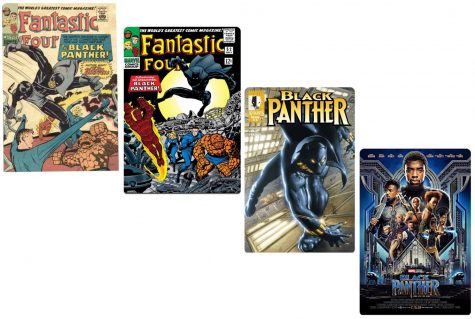The History and the Phenomenon: Black Panther Review
 When the black community heard of Marvel’s plans to bring the Black Panther, a comic that introduced a black superhero, they were hopeful and the end result has made them ecstatic. Is it a coincidence the Black Panther was released during Black History Month? Of course not, this film celebrates black culture and gives the black community a fictitious character to look up to and place they wish they could visit.
When the black community heard of Marvel’s plans to bring the Black Panther, a comic that introduced a black superhero, they were hopeful and the end result has made them ecstatic. Is it a coincidence the Black Panther was released during Black History Month? Of course not, this film celebrates black culture and gives the black community a fictitious character to look up to and place they wish they could visit.
The Black Panther was the first mainstream black character in comics (this was before fan favorites such as Falcon, Luke Cage, etc.). Originally, the black panther had a very different mask: one that showed the lower half of his face. Marvel Comic executives believed that having an black man on the cover of their comics wouldn’t attract readership and thus gave him the iconic mask he has today. As black panther dropped in and out of comics, he soon received his own solo comic and before long was featured in some animated films alongside other Marvel heroes. It wasn’t until 1998, in Black Panther Volume 3, that black panther was given the vibranium suit that has become such an important aspect of his character.
Taking place after the events of Captain America: Civil War, the film centers around T’Challa (Chadwick Boseman) becoming king and the black panther. Faced with the opportunity to bring Ulysses Klaue (Andy Serkis) to justice for his crimes against Wakanda, T’Challa, Okoye (Danai Gurira), and Nakia (Lupita Nyong’o) travel to Korea to prevent the sale of an old vibranium artifact (that was stolen by Klaue and Erik “Killmonger” Stevens (Michael B. Jordan) from a museum) and thus bring Klaue to justice. Things get tricky however when they run into Agent Ross (Martin Freeman) of the CIA who is also attempting to arrest Klaue. After an intense fight scene that showcased amazing Wakandan tech, Klaue is detained. As Agent Ross goes to talk to him, Klaue convinces him to be skeptical of the Wakandans and what they’re telling the world. The main villain, Killmonger, then shows up and breaks Klaue free only to later turn on him and use Klaue as his ticket into Wakanda. Killmonger then challenges T’Challa for the throne and wins. Wakanda thus becomes divided of those loyal to the throne, such as the Dora Milaje (the all women royal guard), and those who are now refugees and must flee, such as the royal family.
Not only was the film filled with lots of action packed fight scenes where Wakandan technology is shown in all its glory, but the women of Wakanda were pivotal characters through the film. My personal favorite was the genius that is T’Challa’s sixteen year old sister, Shuri, someone who would put even the geniuses that are Tony Stark and Bruce Banner to shame. The Dora Milaje, the king’s all female guards, were amazing in the various fight scenes; they’re lead by Okoye, the general of the guards, who is a stoic individual and probably Wakanda’s best fighter. Nakia is another one of the amazing female warriors in Wakanda; though she is T’Challa’s ex-lover, that doesn’t stop her from completing her duties as a War Dog (a Wakandan spy). And lastly, the Queen Mother Ramonda (Angela Bassett) shows a very clear window into African culture through that fact that older women are considered to be mothers and treated with respect due to the wisdom they provide to their communities; this especially shines through later on in the film when she becomes a refugee in her own country.
Though this is director Ryan Coogler’s third film to date, many have described it as a cultural phenomenon. It’s understandable why there was such a large positive reaction to the Black Panther film: it’s a gorgeous film even if you aren’t into comic books. The cinematography, lighting, and scenes are absolutely stunning; one thing is especially clear from just the scenery alone: Wakanda is a beautiful, technologically-advanced country. Those who are fans of the comics will love the fact that each character has their own motivations and are true to the comics. There has been slight controversy regarding political statements in the film and though the movie may not be political in nature, some of the characters’ motivations are very much so- Killmonger is one of those characters; two statements that were really impactful to Killmonger’s plan and, incidentally, historically charged were “How do you think your ancestors got these? You think they paid a full price for it? Or did they take them like they took everything else?” and “Nah, bury me in the ocean with my ancestors that jumped from the ships. Because they knew death was better than bondage.” Finally, young and old black people can look up to a superhero, a super genius, or warrior and relate to them and their culture. Instantly, after the film premiered, there were many posts on social media regarding the film and Wakanda. Many projects popped up encouraging people to buy tickets and popcorn for underprivileged black youth. The Walt Disney Company has even donated one million dollars to the Boys & Girls Clubs of America to expand their youth STEM programs and build a STEM Center of Innovation in Oakland, California (the city that the film’s villain originated from).
What’s really refreshing about this film, is the fact that it’s a small film. It only focuses on Wakanda and the political turmoil that captures it once Killmonger attempts a coup and actually succeeds. This is especially considering the fact that Avengers: Infinity War is a film that will premiere later this year and contain a lot of information and characters. Speaking of other Marvel films, one thing Marvel tends to fall short of is the lack of well-developed villains that actually make the audience fear or sympathize with them. Killmonger is a villain that does not fall into that category. He’s complex and dangerous. Even though he uses a bit of comedy, it’s the way he delivers the lines that makes you wonder if you should be laughing or actually be terrified. He’s the type of villain that Marvel should really work more towards creating.
The film made $202 million domestically on its opening weekend ($426 million worldwide) and made $108 million in its second week, which is $5 million more than the Avengers made in its second week. The only film that has earned more in its second week was Star Wars: The Force Awakens. These totals have passed every X-Men film (excluding Deadpool), Justice League (by more than $14 million), and ⅓ of the films produced by Marvel. The film is estimated to reach up to one billion in revenue worldwide. When presale tickets went on sale, Black Panther broke Marvel’s presale ticket record. It had the fifth biggest opening for a film in history and may even rise into a top ten spot on the list of highest grossing superhero films ever created. Currently, the film is creeping up to steal Captain America: Civil War and Iron Man 3’s spots as the third most successful Marvel film. It’s received an onslaught of positive reviews (such as a 97% on Rotten Tomatoes) and the Black Panther album is currently on its second week of being number one on the charts. The Black Panther is best reviewed superhero film out of all films that have been previously produced. All signs point to Black Panther possibly even making into the highest grossing domestic films of all time.
- Black Panther came out on February 16 and was given a PG-13 rating.





